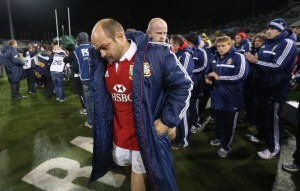
Too much mustard on it: The Lions have been under pressure and wayward in the lineout at points during this tour
By Alan Dymock
THE STATS don’t make good reading after the British and Irish Lions 14-12 loss to the Brumbies.
Despite their win the Brumbies carried 23 times less than the Lions, with 22 carries. They did so for 104 metres less, with only 188m gained to the Lions’ 292. They made one clean break to the Lions three and lost the ball to penalties, knock-ons or turnovers more often with 17 coughed up compared to the Lions’ 14. However, they scored a try when the Lions did not and they made 112 tackles compared to the Lions 69 during the try-line shut-out.
There is a greater issue than this, though. While the Brumbies slowed and slugged away at the breakdown, irritating the Lions before rushing at them with supercharged shoulders, it was the lineout that dismayed fans of the tourists more.
It became apparent early on in the game that hooker and captain Rory Best was having a bit of a wobble – a similar wobble to a blancmange in a flight simulator – and that the Lions needed to claim ball and drive. So Ian Evans called the ball for himself and took it cleanly four times.
That may not seem a lot, but the Lions lost eight lineouts during the game, with four stolen and desperately needed possession.
In the end the tourists claimed 13 of their own throws and stole three. It is a simple fact that any momentum is killed when the hooker lobs a squiggler or was picked off, particularly when the team is against it at the ruck and their dejected hooker has to mash into a scrum.
This problem is not a new one. The Lions may have blitzed Combined Country but they lost three lineouts to the strugglers. They lost two as the smashed the Western Force and three when they were hustling past the Barbarians. The common denominators in those games has been Best and Richard Hibbard.
Defensively there are bright sparks, as Geoff Parling stole four lineouts against the Reds and one against the Waratahs. Tom Croft also pinched a lineout off the Waratahs, while Evans and Gray have taken four collectively all tour. Paul O’Connell and Alun Wyn Jones have nabbed three together.
Evans is miles ahead in terms of calling to himself, taking a staggering eight lineout balls against the Combined Country, which is the same number Jamie Heaslip has taken throughout this tour. When others are playing the ball is spread around a lot more, with O’Connell only taking one lineout per game in the two matches he has started.
Therefore, the statistic both point to straightforward solutions, as well as creating some additional issues for the selectors.
A lineout bossed by O’Connell ensures variety. Twin him with Parling and there is a chance more opposition ball will be stolen, while Jones is happy to play the target as O’Connell is running misdirection plays. With such variety, Parling could happily slot in but he is more of a defensive player who can climb up there, but a positive Gatland means the Englishman could spring from the bench.
If Gatland is that positive, picking to attack rather than stifle, then Croft and Heaslip are instant selections for belligerent lineout rugby.
Nonetheless, all of this is irrelevant if these jumpers cannot be hit. Tom Youngs is the most confident of the hookers and is making slightly less slip-ups. The efficient and well-oiled set-piece under O’Connell could sweep Youngs along with it and Hibbard could also be caught in O’Connell’s slip stream.
Pressure is a given at Test time, though, and Hibbard must be made to believe in his throwing and it would be no surprise if he ends up rooming with O’Connell, Jones or even Heaslip in this Test window.
Best would do well to be paired with one of these, too, because if there is one thing we have learned from this tour it is that players can be scythed by injury at any time and the Ulsterman definitely has a part to play yet. He needs to believe in the cause and he needs help. His team mates can help him get over his lineout yips.







